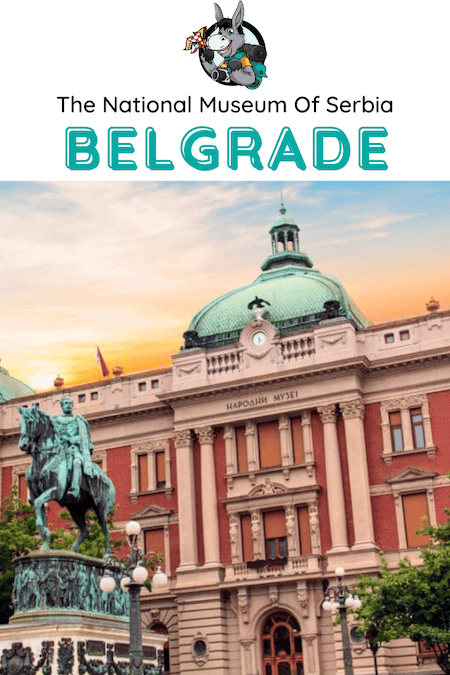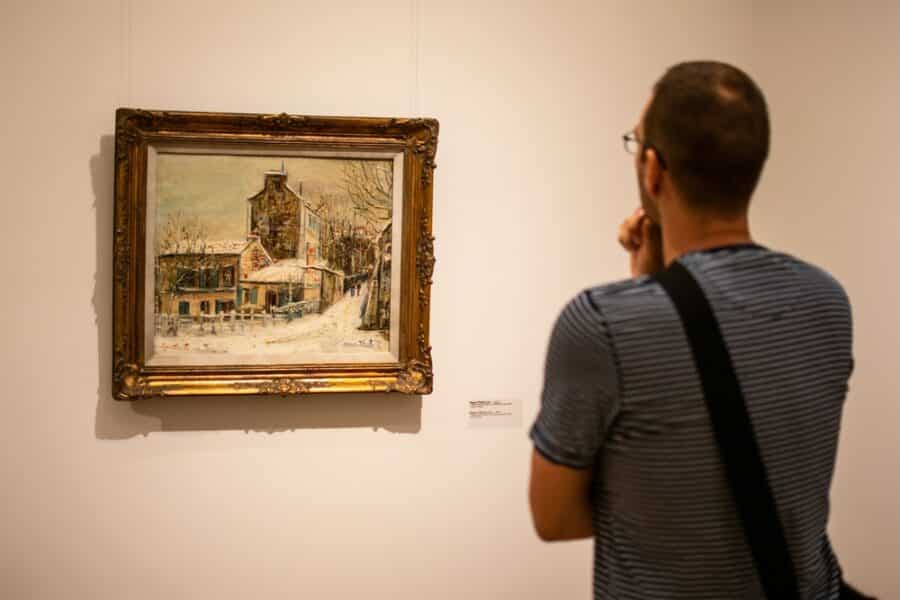Written by Steve from Art History.
The National Museum of Serbia is the largest and oldest museum in Serbia. It has moved many times in Serbia throughout its history and contains not only Serbian artworks and national treasures but also a great collection of European art.
Skip Ahead To My Advice Here!
Is It Worth Visiting The National Museum Of Serbia In Belgrade

YES! The building itself is a beautiful example of the Byzant-Serbian revival style. It holds 400,000 objects, and there are thirty-four collections. It is located in the cultural and political heart of the Serbian capital, Belgrade. Here you can learn of Serbia’s turbulent and dramatic history and enjoy European art masterpieces.
About The Museum
The museum is near Republic Square in Belgrade, in the city’s center. Among the nearby attractions are the National Theatre and the statue of Prince Michael.
- Address – Trg republike 1a, Stari grad, 11000 Belgrade, Serbia
- Museum Hours
- Tuesday: 10 am – 6 pm
- Wednesday: 10 am – 6 pm
- Thursday: 10 am – 8 pm
- Friday: 10 am – 6 pm
- Saturday: 10 am – 8 pm
- Sunday: 10 am – 6 pm
- Monday: Closed
- Public Transportation To Museum
- Station Trg Republike
- Buses: 24, 26, 27, 27E, 31, 32E, 35, 37, 43, 44, 96
- Trolleybuses: 19, 21, 22, 22Л (22L), 28, 29, 41
- Mini Buses: E2, E8
- Stations Dom Omladine & Skadarska
- Buses: 16, 58, 95
- Mini bus: E6
- Station Trg Republike
- No On Site Parking – Park cars in public parking garages nearby
- Parking Garages
- Obilićev Venac
- Zeleni Venac
- Rajićeva
- Hotel Hilton
- Parking Garages
- Ticket Cost
- 300 RDS for the permanent collection
- 500 RDS for temporary exhibit
- 600 RDS for both permanent collection and temporary exhibit
- 50% off ticket price for students
- Free for children 7 & under every day and free for everyone on Sundays
- Guided Tours are available on Saturdays at 6 pm

National Museum Of Serbia In Belgrade History
The National Museum was established in 1844 and has been held in several locations over the last century and a half. During World War 1, the collection was housed in a private residence, and soldiers later looted it during the Austro-Hungarian occupation of Belgrade.
During the interwar period, the collection was kept in a rented building. During WWII, the collections escaped much damage during the German bombing of Belgrade in April 1941. However, they were damaged during the Allied bombing in 1944.
After the Communist takeover of Belgrade, the Museum was transferred to its present location, the New Palace, which was once owned by Serbian Royalty and later a bank. The museum was extensively renovated between 2008 and 2018. Some of the greatest masterpieces in the Museum were donated by members of the former Serbian Royal family.
Brands We Use And Trust
What To See At The National Museum Of Serbia In Belgrade

Once you have decided to add the museum as a stop on your Belgrade things to do list, you will find a remarkable archaeological collection consisting mainly of Roman, Greek, and Byzantine artifacts.
Among them is a fine example of the bust of the Roman Emperors Diocletian and Marcus Aurelius. There is also a magnificent collection of Ancient and Roman Greek coins, including some that were issued by Alexander the Great.
There are also fine examples of weapons and armor from Classical times. The museum has a remarkable collection of Ancient Egyptian artifacts, including a sarcophagus and a mummy.
Among the Medieval collection are many important artifacts from Serbian history when the Serbs were a major power in Eastern Europe. There are also many fine examples of Medieval icons and illuminated manuscripts.
The National Museum of Serbia in Belgrade has the world’s most extensive collection of Serbian art. It also notably has collections from every major European nation.
The Museum has a tremendous collection of Italian Renaissance art, including masterpieces created by Raphael and Titian. At the same time, the Dutch and Flemish collection has many masterpieces, including one of the greatest works of Paul Reubens. There is also a fine collection of Russian and English art.
French art is extremely well-represented and the Serbian Museum, particularly from the Impressionists, including works by Edgar Degas, Claude Monet, and Pablo Picasso.
A particularly fine example of an El Greco is also housed in the Museum along with a large Japanese art collection consisting of drawings, prints, and paintings by greats such as Kunisada and Toyokuni.
Top Paintings In The National Museum Of Serbia

1300s
Madonna and Child by Paolo Veneziano (1355, oil on canvas)
Paolo da Venezia was a 14th-century painter and the founder of the Venetian School, and the official painter of the Venetian Republic. The Virgin is elegantly clothed in a deep blue cloak. She is depicted seated on a golden throne with baby Jesus on her left knee.
Madonna with Christ on the Throne by Paolo di Giovanni Fei (1390, oil on canvas)
This triptych was painted by Paolo di Giovanni Fei, a painter of the Sienese school of Italy whose paintings are characterized by their bright blear palette against a gilded background, as well as his naturalistic and ornamental details. Madonna with Christ on the Throne is the scene in the central part of the triptych, and they are depicted together with saints blessing them.
1400s
Holy Pilgrim and St. Sebastien by Vittore Carpaccio (1495)
Carpaccio was an Italian painter from Venice. In this picture, we see Saint Sebastian, depicted on the right, as an early Christian martyr killed during the Diocletian’s Persecution of Christians.
He was tied to a post or a tree and then shot with arrows that failed to kill him. According to tradition, he was rescued by Saint Irene. Shortly after the rescue, he went to Diocletian to warn him about his sins but was clubbed to death consequently.
One of the most important pilgrimage sites in southern Germany is a Benedictine abbey that was founded on the place where Saint Sebastian’s cranium was brought to in the 10th century, hence the depiction of the Pilgrim on the left.
Adoration by Lorenzo di Credi (1487, oil on canvas)
Di Credi was an Italian Renaissance painter and sculptor who focused on religious subjects.
The main focus of this painting is Christ, lying on a cloth looking upwards at the Virgin Mary, who is in three-quarter view, kneeling right from him with hands in a gesture of prayer. Three angels are depicted left of them, and to the right of the group is Saint Joseph, who is leaning on a rock. All figures have thinly painted halos over their heads which follow the central axis of the face.
1500s
Madonna with Christ and small St. John (1500s, attributed to Raphael)
This painting is attributed to Raffaello, an architect, and painter of the High Renaissance whose work, together with the works of da Vinci and Michelangelo, forms the trinity of great masters of that period. It depicts Madonna dressed in a burgundy dress and dark blue veil, looking over at nude baby Jesus, while St John is almost with a smile looking at the observer.
Portrait of Catherine of Austria by Titian (1556, oil on canvas)
Titian was the greatest Italian Renaissance painter of the Venetian school who was recognized in his lifetime as a supremely talented painter, and his reputation never suffered a decline.
Catherine of Austria was the Queen of Portugal and the wife of King John III. This portrait depicts her in the uppermost luxurious dress and jewelry with a dog to her left, while her figure eludes confidence.
Portrait of Queen Christina of Denmark by Titian (1555–1556, oil on canvas)
This painting depicts a Danish princess and the younger surviving daughter of King Christian II of Denmark and Norway and Isabella of Austria. Christina of Denmark served as the regent of Lorraine during the childhood of her son and was a claimant to the thrones of Denmark, Norway, and Sweden.
Her portrait was painted by Titian, an Italian painter of the Renaissance and the most important member of the 16th-century Venetian school. The painting was part of the collection of Mary of Hungary in the 16th century and, before World War 2, was part of the Contini Bonacossi Collection.
1600s
Diana Presenting the Catch to Pan by Peter Paul Rubens (1615, oil on canvas)
Rubens was a Flemish artist and diplomat, the most influential figure of the Flemish Baroque tradition.
Goddess Diana is depicted standing with her companions before a group of satyrs. Her hunting spear divides the different worlds of the two groups. The fruit presented in laden baskets and the wine, combined with the gazes of half-nude figures, can be interpreted as an unambiguous erotic overture. The animals and fruits in this painting were painted by Frans Snyders. Another painting in Dresden is almost identical to the Belgrade version but is smaller in size.
The Music Lessons by Frans van Mieris the Elder (1650, oil on canvas)
Van Mieris the Elder was a Dutch Golden Age portrait and genre painter. This genre scene depicts a seated woman with a sheet of musical notes in her left hand while a musician is showing her the right notes on the violin.
1700s
Stairway of Farnese Palace Park by Hubert Robert (1770s, oil on canvas)
Hubert Robert was a French painter of the Romanticism school who was noted for his landscapes and capricci or semi-fictitious picturesque depictions of ancient ruins in Italy and Florence. Farnese Palazzo is one of the most important High Renaissance palaces in Rome, and this painting depicts figures washing their clothes in the water of the fountain that has lost its excellence.
1800s
Rouen Cathedral by Claude Monet (1892, oil on canvas)
Monet was the founder of impressionist painting and a key precursor to modernism. The Rouen Cathedral series represents a collection of more than thirty paintings completed in 1892 and 1893.
They all represent different weather conditions and times of day, visible on the Cathedral. This painting is also called Rouen Cathedral, red, Sunlight, and shows the front of the Cathedral bathing in the morning sun.
Portrait of Karageorge by Vladimir Borovikovsky (1816, oil on canvas)
Black George was a Serbian revolutionary who led the struggle for his country’s independence from the Ottoman Empire during the First Serbian Uprising (1804-1813). Following a massacre of Serb chieftains by Ottoman janissaries (also known as Dahis), the Serbs rebelled, and Karageorge was elected to lead the uprising.
The uprising was partially successful and was later burdened and weakened by Napoleon’s Invasion of Russia in 1812, together with frequent infighting. Karageorge was forced to leave Serbia in 1813 and fell ill, bringing the First Serbian Uprising to an end. He returned to Serbia five years later and was killed by agents of a rival rebel leader, Milosh Obrenovich.
This portrait was painted by a Russian Imperial artist who was the central figure of the 19th-century Russian Empire portrait painting.
Tahitian Girl by Paul Gauguin (1886, oil on canvas)
Gaugin was a post-Impressionist artist who is recognized for his experimental use of color and Synthetist style. In his later years, he spent ten years in French Polynesia. Tahitian girl is a great example of Gaugin’s use of bold colors, exaggerated body proportions, and stark contrasts that paved the way for the Primitivism art movement.
Place du Theatre Francais: Sun effect by Camille Pissarro (1898, oil on canvas)
Pissarro was an Impressionist and Neo-Impressionist painter. This painting belongs to a series of 15 paintings of view from the Grand Hotel du Louvre in Paris, which are depictions of various scenes of the Place du Theatre Francais, the Avenue de l’Opera, and the rue St Honore.

